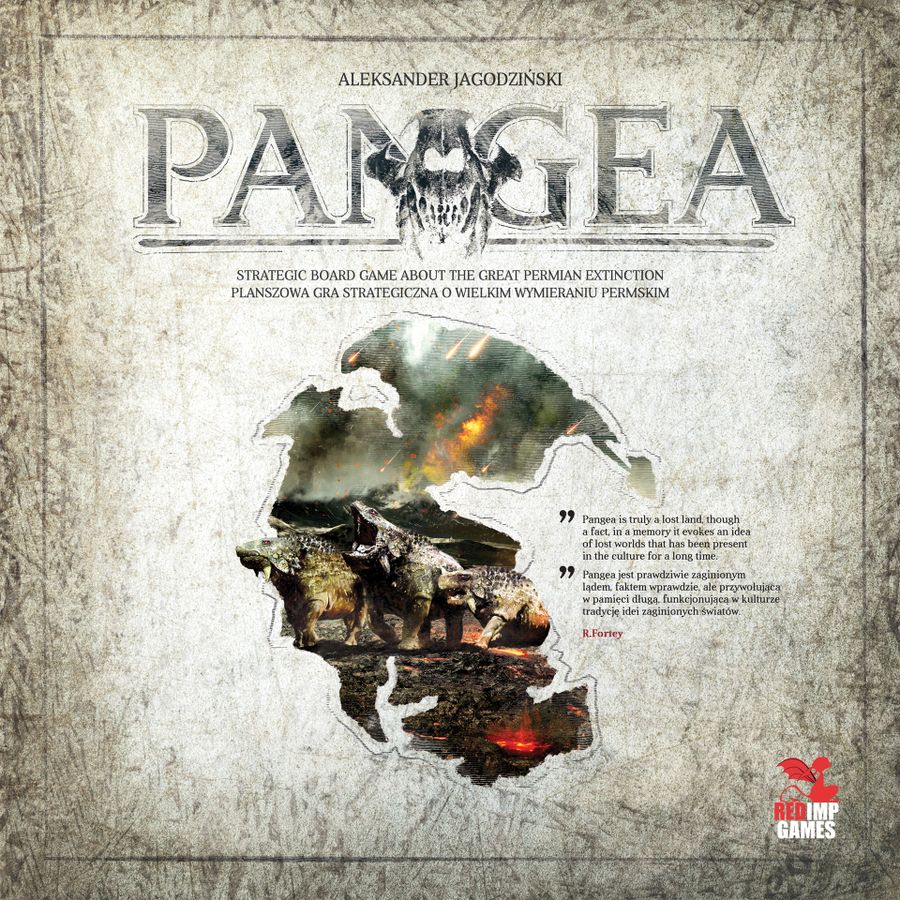Kickstart This! #51: Pangea

Designer: Aleksander Jagodzinski (Zercy)
Artist: Aleksander Jagodzinski (Zercy), Joanna Kwasniak
Publisher: RedImp Games (Achaia, The Lord of the Ice Garden, Martians: A Story of Civilization)
Genre/Mechanisms: action point allowance system, area control, area movement, card drafting, miniatures, time track, variable player powers
Funding Status: At the time of this posting, Darwinauts is already fully-funded. In fact, pledges currently total almost 10x the initial funding goal, with 3 days left to go on the campaign.
Player Count: 1-4
Solo Mode: yes
Complexity: heavy
Risk: medium-high
What It’s About: To date there have been five mass extinction events on planet Earth. The most widely studied mass extinction event occurred during the Cretaceous period, 66 millions years ago, and took out the dinosaurs and three quarters of all planet and animal life. But the largest mass extinction took place 299 million years ago during the Permian period, when much of the planet’s land mass was still formed into the supercontinent of Pangea. In Pangea, play as the Synapsids, Sauropsida, Amphibians, or Invertebrates (with some very cool, KS-exclusive, animal fossil miniatures) as they prepare for the coming cataclysm by evolving and locating ecological niches as far from the center of the catastrophe as possible.
How It Works: Pangea plays in 9 Stages over 3 Epochs: 4 Stages during the Cisuralian Epoch, 3 Stages during the Guadalupian Epoch, and 2 Stages during the Lopingian Epoch. Between each Epoch is a Turn of the Ages with a Cleanup Phase, Event Phase, and Development Phase. All Hunger Markers are removed from the game during Cleanup; a new Turn of the Age Card is revealed during the Event Phase; and the Objective Tiles are replaced with tiles for the new Epoch during the Development Phase.
Over the regular 9 Stages of gameplay, each Stage is comprised of 5 Phases: Neutral Animals Phase (in a 1-3 player game only), Drawing Phase, Action Phase, Survival Phase, and Initiative Phase. If there are no Neutral Animals currently on the board, they’ll be randomly assigned to an area and placed during this phase. In the Drawing Phase, players will draw 2 more Adaptation Cards, discard down to 3, and place their new Adaptation Cards on their Animal Board in the Inactive Card Zone. During the Action Phase, players take actions in turn order by placing their Action Marker on their Animal Board, and then adjusting their Action Point Marker downward on the Action Point Track by the appropriate number of points. The available actions during this phase include Adapt, Populate, Migrate, and Survive. Adapting allows the player to take the action on an Adaptation or Evolution Card. Populate allows the player to place an Animal Marker or Special Animal Marker in an Ecological Niche. Migrating is used to move Animal Markers or Special Animal Markers already on the board. And Survive allows players to look at the Instinct Tile to determine the coming Cataclysm. Hunger is resolved during the Survival Phase, and will affect players’ Dominance Points. The Doom (round) Marker moves during the Initiative Phase, and the Initiative Order is adjusted by current Dominance points.
When the Doom Marker reaches the end of the Epoch Phase, the game ends. The 3 Instinct Tiles are revealed, pinpointing the center of the Cataclysm. All orthogonally adjacent regions are also affected. Animal Markers are removed from all affected regions, as well as from any level 0 or level 1 Ecological Niches in the diagonally adjacent regions, and the type of Cataclysm is resolved. Players receive 1 Dominance point for any surviving Animal Markers, plus a number of points equal to their corresponding Ecological Niche level. Ties are broken by whoever has the most Animal Markers on the boards, and then by the position on the Initiative Track.
Comparisons: Perhaps the closest comparison is Evolution, except for the fact that Evolution is more confrontational, contains more combat and take that, and is all about prospering largely by conquering your enemies. Pangea has occasional combative actions, but is more about surviving, period, and the factions in the game often do this more efficiently through other types of actions. Plus, Evolution doesn’t have Pangea’s cool-looking, KS-exclusive, fossil miniatures.
What Should I Pledge?:
$55 Diplocaulus: the Core Box will all related unlocked stretch goals.
$106 Diplocaulus Deluxe: the Diplocaulus pledge, plus the following add-ons: the Doom Marker, 7 Hunger Markers, 28 Animal Miniatures, 4 special Animal Bases, 15 Miniature Bases, Cotton Bag.
Add-Ons:
$3 The Doom Marker
$5 7 Hunger Markers
$35 28 Animal Miniatures & 4 Special Animal Bases
$5 15 Miniature Bases (9 Toxicity Bases + 6 Inactivity Bases)
$5 Cotton Bag
KS Exclusives:
The Doom Marker, all of the miniature upgrades (and bases), and the Cotton Bag are all KS-exclusive.
All-In Total: In the continental U.S. you’re looking at $106 for the Diplocaulus Deluxe pledge plus $15 in shipping for a total of $121.
Pangea completes its Kickstarter on Monday, July 15th and tentatively ships in April 2020.